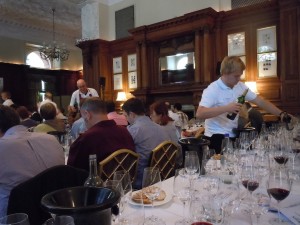2001 is a fine vintage, especially in Pessac Leognan: horizontal in June, 2012
June 19, 2012
For the first time ever the official council of the appellation of Pessac Leognan organized a tasting of its wines in England, after the appellation was created just over 25 years ago in 1987.
Although the appellation is young, the wines from this northern Graves region count among the oldest of Bordeaux – long before the Medoc became famous.
Panellist Olivier Bernard of Domaine de Chevalier reminded participants that the unquenchable English thirst for claret began in the 14th century with wines from this region of Bordeaux, dominated by the top estate Chateau Haut Brion – the only non-Medoc red wine to be included in the famous 1855 Classification.
Today the wines of Pessac Leognan number 74 chateaux and domains in some 1,700 hectares. Pessac Leognan includes all the classified growths from the Graves region, from a classification dating from the 1950s. They all lie in the northern part of the Graves.
Unlike the two other master classes this past Saturday, the Pessac Leognan tasting was a horizontal – meaning different chateaux and one vintage, in this case the “insider’s” 2001.
With many wine buyers focusing on 2000, the 2001 vintage was very successful on the Right Bank, particularly for Merlot. But connoisseurs know that the wines of the Graves region – even though on the Left Bank – can just as often mirror successful vintages of the Right Bank.
2001 is one such vintage, Bernard explained to the audience, because the Merlots were very successful, and Merlot is often used as much as Cabernet Sauvignon in the Graves region. Estates such as Picque Caillou and Larrivet Haut Brion, featured at this master class, for example, included 50% Merlot in their 2001 blends. Most others had at least 35 to 40% Merlot. Furthermore, there is sometimes a tendency for Cabernet to ripen more quickly than in the Medoc, given its more southern location.
The interest for this master class was such that David Launay, the representative who had earlier presented Chateau Gruaud Larose in an earlier master class, was keen to try the 2001s.
An added treat for participants: chateau representatives from each of the ten estates briefly described their wines although the tasting was guided by Bernard and Laurent Cogombles of Chateau Bouscaut, president of the Pessac-Leognan wine council.
Highlights in the first flight of five wines included a very elegant Chateau Larrivet Haut Brion – described by Bernard as quintessentially Pessac Leognan in style, displaying tobacco and mineral notes in a supple, yet concentrated manner.
Lesser known estates were also present, including Chateau Bardins and the aforementioned Picque Caillou, whose owner Paulin Calvet explained the importance of the gravely soils of the Pessac Leognan, comprising quartzes and quartzite in various colours: perfect for drainage, he remarked, when some rains fell in 2001.
Also in the first flight of five wines: a rather rich and robust Chateau de Fieuzal, which David Launay liked in particular. Annabelle Denis, communication officer for the estate described how the vintage was borne of a mild winter and wet spring, a normal flowering, constant and rather cool summer temperatures, with precipitation. “It was a late vintage with a fine Indian Summer,” she said. “We waited until mid October to end the harvest.”
The next flight of five wines may have proved more interesting overall, beginning with an excellent Chateau Latour Martillac 2001. Director Valerie Vialard (who is married to Gabriel Vialard of Chateau Haut Bailly) explained her passion for Petit Verdot – much to Launay’s delight. Here the 40% new oak was nicely integrated for the blend of 60% Cabernet Sauvignon, 35% Merlot and 5% Petit Verdot.
Olivier Bernard made some interesting comments distinguishing tobacco notes from smoky notes, so common in the wines of Pessac Leognan. The tobacco aspect seems to be more pronounced from terroirs closer to forested areas such as his own Domaine de Chevalier, he said, whereas smoky aspects tend to be more pronounced in estates in the northernmost part of the appellation, such as La Mission Haut Brion and Pape Clement.
Presented by co-owner Jean-Jacques Bonnie, Chateau Malartic Lagraviere 2001 proved to be among the best of the tasting: rich and full-bodied, with fine sap. And Chateau Smith Haut Lafitte was quite seductive and smooth in character.
But for David Launay – and for myself – the wine of both flights in this lovely horizontal was the legendary Chateau Pape Clement: round and rich – and, yes, smoky with fine mineral aspects. This was a vintage that perhaps suited this estate, which can sometimes make large scaled, modern wines, but in 2001, there was excellent classicism to the wine.

